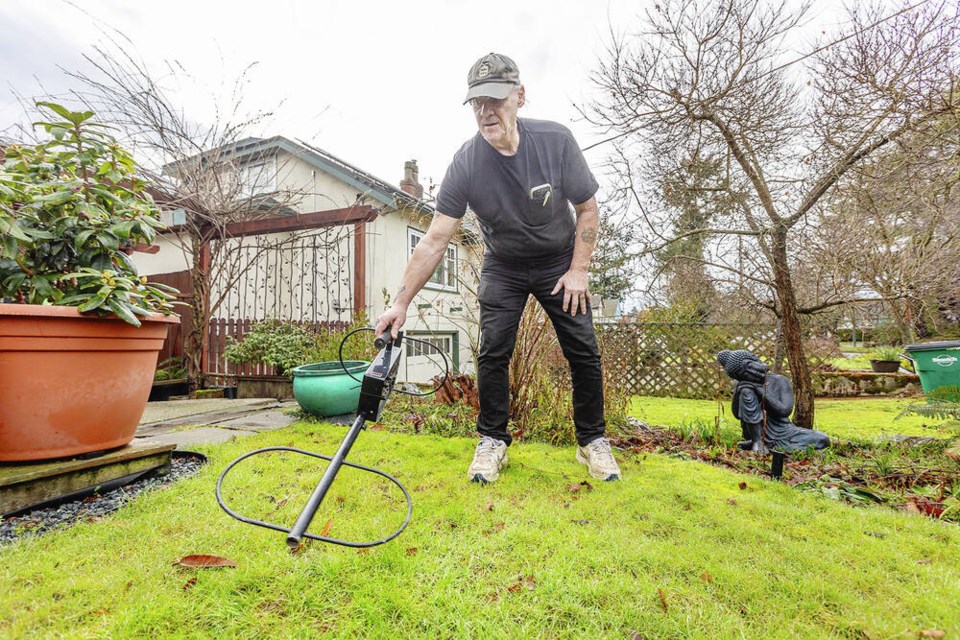Rick Hughes says his father used to get paid $5 to dig trenches for underground tanks in the 1950s.
“They would just drop him off in the morning with a shovel and pick and let him go at it,” said Hughes, owner of Victoria Tank Service, adding his father was a firefighter at the time and the tank job was a sideline. Now Hughes, 68, spends five days a week finding those same tanks so his son Corey can dig them out, so they don’t corrode and leak oil into the surrounding soil and water — as happened this week at Swan Lake.
Underground tanks were common in homes built before 1957. They were phased out by about 1961 and above-ground tanks were used instead.
Hughes said he is usually called to do an inspection by a real estate agent who has just listed a pre-1960s house.
At the property, he scans the ground with an industrial-grade metal detector, listening for the “bweep” of the detector when it encounters metal.
He said 90 per cent of the tanks are within five feet of the house. The exceptions are typically when there is bedrock close to the house.
Tanks typically hold between 300 and 500 gallons of oil. Those with the lower capacity would be three-by-six-feet long, while higher capacity would be four-by-six feet.
The trouble is that the tanks are made of metal that rusts over time.
“When we dig them up, they are full of holes, like Swiss cheese,” Hughes said.
There are limitations to how effective a metal detector can be, as it picks up rebar embedded in concrete, or it can’t scan deep enough when there is a ground-level wooden deck.
For a more thorough inspection, the call usually goes out to Western Utilities, which has a ground-penetrating radar machine to “see” under the ground.
“We can literally find a needle in a haystack,” said Stu Millet, owner of Western Utilities. “Instead of just detecting metal, we uncover anomalies in the soil.”
For harder-to-find tanks, he has an ace up his sleeve: a machine that clips onto the copper line that runs from the oil furnace to the tank. The machine sends out a radio frequency that turns the line into an antenna. He then follows the signal to the hidden tank.
Business is good — he said he has located 15,000 tanks in the past 18 years.
Typically, it’s a real estate agent who initiates the call to either company, as the search has been part of a building inspection report and disclosure when selling a house since 1994.
“In the past, when a homeowner wanted to decommission an underground tank, the protocol was to cut a hole in the top of the tank and fill it with an inert material — usually sand. The fire department would then be called to sign off on the work,” said Millet.
Different rules apply now. Any tank located has to be dug up and removed.
If it’s a simple job, the cost of removing a tank is between $2,500 and $3,000, said Corey Hughes, the foreman at Victoria Tank Service.
Costs can climb quickly if, upon the tank’s removal, the soil is found to be contaminated, with removal and remediation costs as high as $20,000.
The soil has to be tested, with results reported in parts per million.
If contamination levels are low, the soil can be removed and trucked to a site in Duncan. If the ground is heavily saturated, the soil needs to be placed in drums to be transported to a facility on the Lower Mainland to be properly disposed of.
Fuel-oil spills are not generally covered under a homeowner’s house insurance policy.
“Most homeowner insurance policies have oil escape exclusions, as remediation costs are insane,” said Cassie Ayers, team leader for property insurance on Vancouver Island for Megson FitzPatrick, a home insurance broker. “But people can get insurance to cover themselves.”
Those who heat with fuels such as oil or wood typically pay a surcharge on their insurance due to the increased risk.
“It’s not exorbitant and doesn’t add a lot to the annual premium, if they meet the [insurance] company’s guidelines,” said Ayers.
She said the brokerage firm would “shop” policies between five main insurance companies and, if necessary, with specialty providers, who would offer coverage with higher premiums.
Policy holders whose homes contain indoor oil tanks are required to replace them after 20 years. That drops to 10 years if they are exposed to the elements. The tanks also need to have double walls or double bottoms. New owners seeking insurance are expected to furnish proof of a “clean” scan of the property.
“It’s getting stricter and stricter,” Ayers said.
>>> To comment on this article, write a letter to the editor: [email protected]



